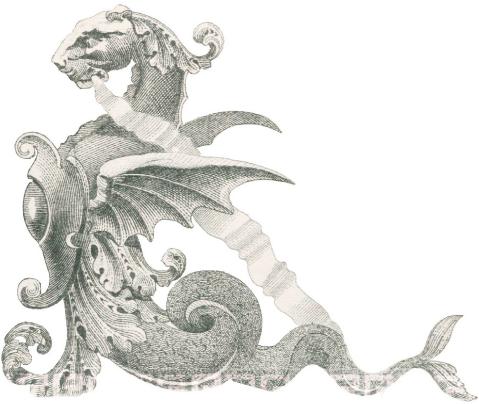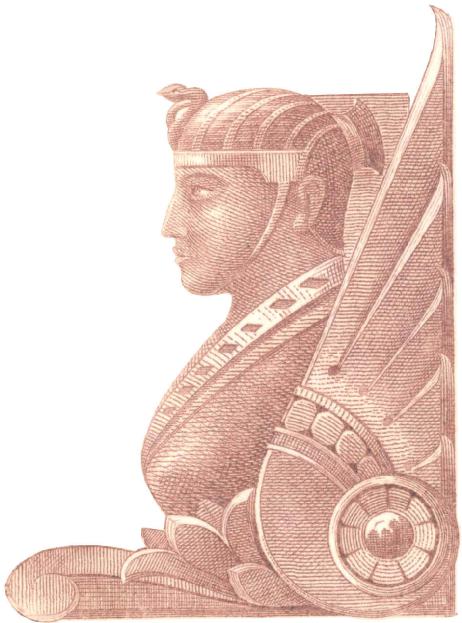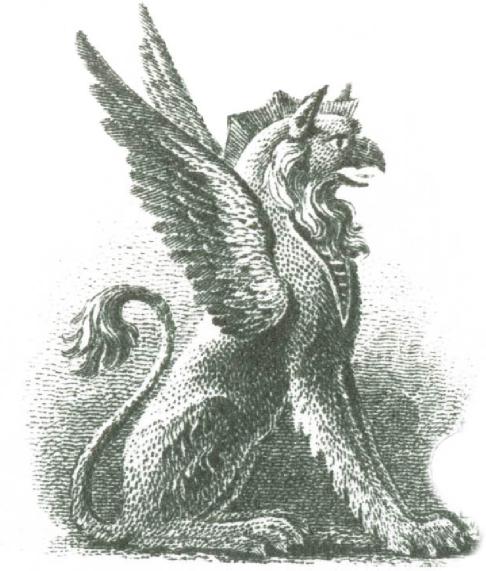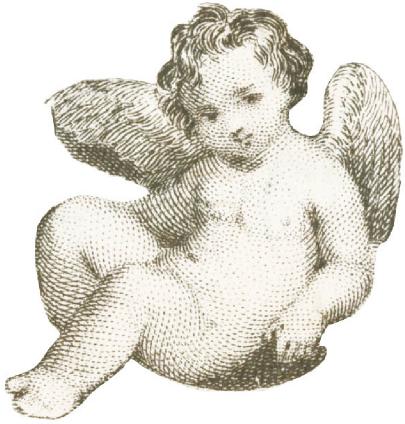
“New” certificates
Where you go in your quest for “new” certificates depends on the kinds of certificates you’re after. (For this article, I define “new” certificates as those that collectors have seldom if ever encountered.)
In the last year and a half, hundreds of new specimen and proof certificates from the American Bank Note Company archives have come up for sale. This large number is cataloged by Archives International and is selling through H.R. Harmer. More modest numbers of specimens and proofs appear in Smythe and Winslow sales, but the overall number has been dropping in recent years.
Unless you have good reasons to avoid specimens and proofs, this is a terrific time to acquire stunning and new certificates. Proofs are one-of-a-kinds items and once sold will rarely re-appear for resale. Once they enter collections, proofs stay hidden for years, even decades. Specimens are only slightly more common.
 Unusual winged-serpent gargoyle-like ornament, typically used in the bottom borders and backs of bonds. These elements were never overly noticeable because they were printed in border colors. They nonetheless played serious roles as security measures.
Unusual winged-serpent gargoyle-like ornament, typically used in the bottom borders and backs of bonds. These elements were never overly noticeable because they were printed in border colors. They nonetheless played serious roles as security measures.
From the number of images I receive, it appears that average collectors focus mostly on regular certificates, especially issued certificates. Fortunately, a small number of new issued certificates appear in most professional auctions. Obviously, there can be substantial competition for these kinds of certificates, so prices tend to be strong. If on the hunt for new issued certificates, your most reliable sources will be professional auctions.
I have found that professional dealers are also really good sources of new certificates. Obviously, the number of new certificates is extremely limited, so their appearances in dealer inventories is limited and unpredictable. Shop around to learn which dealers specialize in new material and which stick with tried and true favorites. Understand, that all professional dealers stumble across new material from time to time. Form good relationships with several dealers today if you want to be in line to get those certificates in the future.
Understandably, beginners usually start in the hobby by collecting low-priced certificates, meaning they are big buyers of unissued certificates. Many buy exclusively from eBay, never realizing that professional dealers hold the largest, most diverse quantities of unissued certificates. Because of low profits, dealers just cannot afford to advertise them. Dealers can be great sources of “new” and “new to you” certificates.
573!!! New varieties of certificates since April
|
April
letter |
This
letter |
| Number of certificates listed (counting all variants of issued, specimens, etc.) |
22,280 |
23,000 |
| Number of distinct certificates known |
16,871 |
17,444 |
| Number of certificates with celebrity autographs |
1,674 |
1,706 |
| Number of celebrity autographs known |
348 |
347 |
| Number of railroads and railroad-related companies known |
25,521 |
26,043 |
| Number of companies for which at least one certificate is known |
7,033 |
7,156 |
| Serial numbers records |
81,632 |
85,570 |
Most collectors know that eBay is a moderately good source for new certificates and I have recorded some great prices. I have noticed that when new certificates appear on eBay, prices are often overly low. It seems like this may be the result of collectors fearing that new
certificates might be the first of large hoards. Price behavior on eBay is frequently counter-intuitive. I have recorded many, many instances where prices were oddly low when certificates first appeared and then increased as subsequent certificates hit the market.
Antique malls and antique stores can be curiously good spots to find new certificates. Discoveries are, of course, terribly unpredictable. Stories from advanced collectors suggest that if you can be persistent, you have good opportunities of finding scarce certificates amongst piles of magazines, ephemera, and old fashioned junk.
Conversely, my experience strongly suggests that flea markets and garage sales are terrible places to find any certificates, let alone new ones. Collectors in other parts of the country may disagree, but I have rarely seen certificates for sale. When they do appear, they are exceedingly common with unrealistic asking prices.
Certificates do occasionally appear in estate sales. If you live in an area with many estate sales, your best use of time would probably be spent in forming relationships with estate sellers, Try to find ways to get them to tell you when certificates are coming up for sale. I must warn you to be a dependable buyer or your sources will disappear.
Certificates and other paper collectibles appear sporadically at regular antique auctions. You will get your best prices at auctions heavily attended by dealers. My wife and I have found that the worst sales are those populated by collectors and first-timers who always bid prices too high. Always arrive at antique auctions an hour or two early to examine lots.

Large, mature historical societies can be good sources for new material because they constantly need to de-accession donations. Small societies also need to de-accession, but they seldom have policies for ridding themselves of unwanted material. Small historical societies tend to be suspicious of overly zealous inquiries, so proceed cautiously.
Specialized and mature museums are often good sources of certificates. The large Colorado Railroad Museum holds regular mail bid auctions and most sales offer collectible railroad certificates. (Starting prices tend to be high, but it helps to remember that overpayments go to a good cause.)
Collectible stocks and bonds appear in many philatelic shows and auctions. I have found that prices are usually quite acceptable. If there is a downside, it is that certificates are usually under-described.
Certificates also show up frequently at coin shows. If prices appear high, remember that coin dealers are pros at negotiation.
I have sometimes found certificates at collectible paper shows that offer ephemera, postcards, and books. Appearances are not terribly common and, in my experience, paper dealers do not negotiate as well as coin dealers.
Definite regional differences exist. A method of finding certificates that works well in one part of the country may work poorly elsewhere. Out here in the West, artifact collecting is far more popular than paper collecting, so paper prices can be wacky. In my opinion, the greater the familiarity with certain types of collectibles, the more predictable and realistic the prices.
More ABN plates coming up for sale
Stacks will offer more plates from the American Bank Note Company archives in its late July sale. I don’t know what kinds of collectors are buying these things, but they have been dropping some serious dollars, especially for plates related to paper money. Plates related to stocks and bonds have been somewhat more affordable, but do not expect to win with lowball bids like you might on eBay.
Supply, demand and rarity, part 2
 I don’t have the time to research what a cat-like allegorical creature with wings, horns, and beak might have been called, but these weird little engravings typically flanked major features such as company names or prominent vignettes.
I don’t have the time to research what a cat-like allegorical creature with wings, horns, and beak might have been called, but these weird little engravings typically flanked major features such as company names or prominent vignettes.
Of all the variables that affect prices, I consider desirability the most important. At the moments collectors decide to buy things, prices directly represent desires. I argue that rarity is only one of the factors that affects desires, and not a very big one at that. In my opinion, rarity has a muted and very indirect effect on prices.
After I talked about rarity in the last newsletter, a few collectors wrote to tell me how they acquire rarities on eBay at very low prices. I do the same thing and so do most of my correspondents and dealers.
However, maybe we should all ask why we can be successful with such regularity. Are we lucky when we acquire rarities at ridiculously low prices? Are we particularly enlightened? Are we so wise and insightful that we see things that no one else sees?
Or, are we able to buy certificates at low prices because so few other collectors desire them at the same time?
If this is true, then we must ask when are average collectors going to desire those certificates more than we do?
Let’s face facts. The only reason we ever win bids is because we desire those certificates more than anyone else.
Yes, eBay draws millions of people to its huge site every day. But the number of people who actually examine any one particular certificate listing is really very limited. It is rare for more than 50 people – from the whole planet! – to ever look at a particular certificate. I checked several recently-closed sales and found that sales of ordinary, run-of-the-mill certificates typically recorded fewer than nine visitors!
My small, one-day sampling is statistically insignificant. Nonetheless, I contend that we often win auctions simply because there is so little competition.
By comparison, when auction houses such as Smythe, Winslow, FHW, Spink, HWPH, and Tschöpe send out catalogs, they know that hundreds, maybe thousands of collectors will view every certificate.
Remember that the only reason collectors receive those expensive auction catalogs is because they are proven buyers. They are desirous collectors who want to buy rarities. Professional auctions have stables of high-quality buyers. That is why professional auctions routinely attract stronger bids than eBay.
More eyeballs mean better prices!
Yet even among the largest, most professional of dealers and auction houses, with large numbers of desirous collectors, rare certificates go unsold every time. It is blatantly obvious that rare items go unsold because they are not sufficiently desirable at minimum asking prices.
(Yes, some houses’ minimums are much too high, but those are separate problems.) In subsequent sales, though, whether in professional auctions or in amateur eBay auctions, desires change unpredictably. There are always certificates that fail to sell in one auction that ultimately sell for strong, even outrageous, prices in later sales. As I suggested in the last newsletter, wild and unpredictable price swings are hallmarks of small markets.
Certain “rules” predict desirability. As a general rule, collectors desire engraved certificates more than lithographed certificates. They desire vignetted certificates more than plain certificates. They desire older certificates more than newer ones. And so forth.
But there are always, always, always exceptions.
For instance, price behavior proves that collectors desire certificates from the Panama Railroad. Never mind that Panama RR certificates are both dreadfully dull and fairly common.
Some readers may argue that collectors desire imprinted revenues found on many Panama RR certificates. Okay, I’ll concede that point. But then tell me why winning bidders pay nearly identical prices for imprinted and non-imprinted versions.
 Small cherubic children, both with and without wings, were popular space-filler elements. They appeared on numbers of stock certificates. There were often used like small bookends to flank features such as share values, company names, and capitalizations. As printed, they were usually less than a half inch tall.
Small cherubic children, both with and without wings, were popular space-filler elements. They appeared on numbers of stock certificates. There were often used like small bookends to flank features such as share values, company names, and capitalizations. As printed, they were usually less than a half inch tall.
After the last newsletter, a regular correspondent told me he has amassed many low-priced “common” certificates from eBay that are not common at all. He has discovered that several sub-varieties of Union Pacific, Pennsylvania, and B&O certificates are actually rather scarce.
I appreciate this example because it clearly illustrates the interplay between rarity, desire and prices.
It is clear that very scarce sub-varieties exist among so-called common certificates. It is equally clear that average collectors don’t care. They prove with their wallets that rarity alone is insufficient reason to pay more.
That is not to say that tastes and appreciations for rarity will not change in the future. It means that, for the time being, the search for rare micro-varieties remains the purview of specialists.
Although I’ve mentioned it before, I’ll repeat a conversation with a very advanced collector who suggested I avoid going overboard in describing sub-varieties. He argued that “fly-speck scripophily” was pointless. He argued that that it is easy to find tiny variations and hard to find anyone who cares.
So far, prices have proven him correct.